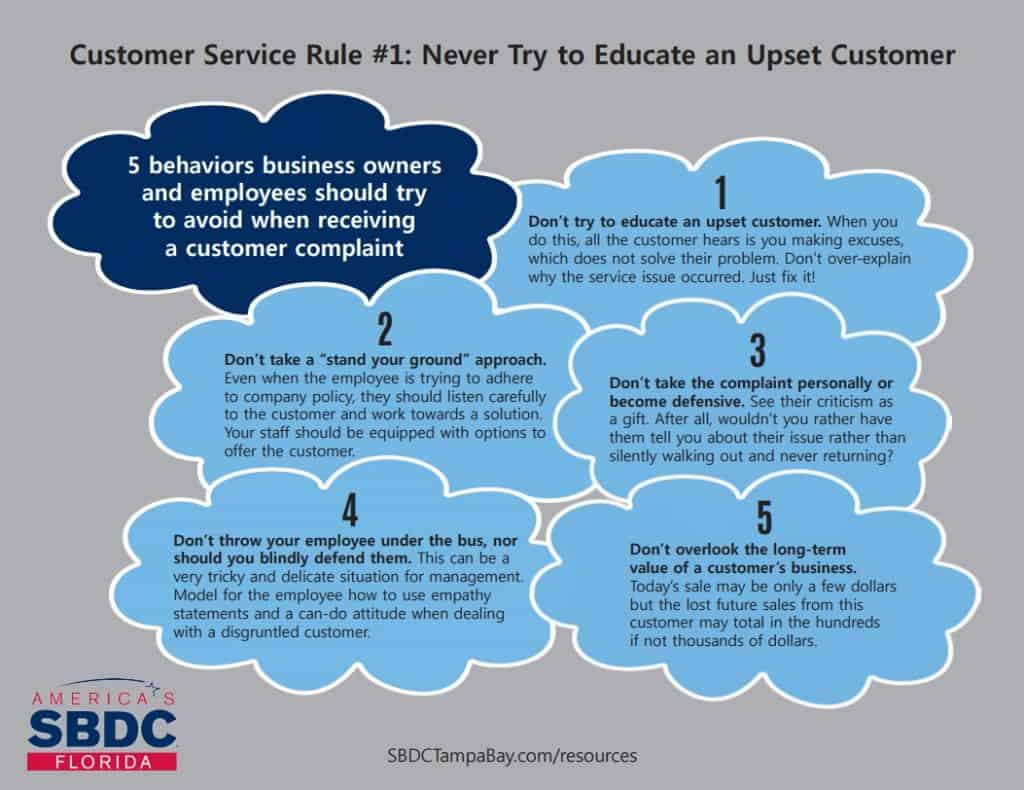Customer Service Rule #1: Never Try to Educate an Upset Customer
by Bill McKown | November 11, 2017
If you are a small business owner, you probably have a customer service problem. After working with small business owners for over a decade now, I have had the opportunity to ask hundreds of small business owners this question: What sets your business apart from your competitors? The most common answer is: “Our customer service!”
This answer would seem legit since a small locally-owned business should be able to cultivate lasting relationships with their customers. In the owners’ minds, I am sure they intend to offer great customer service, but it somehow falls apart when a customer is disappointed and shares their concerns. Too often it becomes painfully obvious many employees and even some owners do not know how to handle a customer grievance.
Here are five behaviors you and your staff should try to avoid when receiving a customer complaint:
- Don’t try to educate an upset customer. When you do this, all the customer hears is you making excuses, which does not solve their problem. Don’t over-explain why the service issue occurred. Just fix it!
- Don’t take a “stand your ground” approach. This may escalate the emotional intensity of the situation. In their best efforts to follow the directives you have laid out for them, employees will often use those most dreaded words that disgruntled customers absolutely detest – “it’s company policy.” Even when the employee is trying to adhere to company policy, they should listen carefully to the customer and work towards a solution. Your staff should be equipped with options to offer the customer.
- Don’t take the complaint personally or become defensive. See their criticism as a gift. After all, wouldn’t you rather have them tell you about their issue rather than silently walking out and never returning? It’s better to deal with the problem while the customer is still in your establishment instead of reading about it in a scathing online review.
- Don’t throw your employee under the bus, nor should you blindly defend them. This can be a very tricky and delicate situation for management. Walking both parties back from the edge is really about avoiding the appearance of placing blame or fault on either the customer or the employee. A better approach would be to model for the employee how to use empathy statements and a can-do attitude when dealing with a disgruntled customer.
- Don’t overlook the long-term value of a customer’s business. Today’s sale may be only a few dollars but the lost future sales from this customer, as well as their friends and family members who may be influenced by their unhappy reviews, may total in the hundreds if not thousands of dollars.
Small businesses can easily capitalize of their unique opportunity to build relationships with their customer base. It starts with the business owner establishing a customer-centric culture by setting measurable standards of good customer service, then teaching the team members by example.
To help close the loop on truly understanding the customer experience while in your shop, make use of on-site or email follow-up surveys. These forms of feedback will either confirm your business is as good as you think it is at providing great customer service, or it will glaringly point out the deficiencies.
Every business makes customer service mistakes. It’s what you do afterward that makes the difference.





